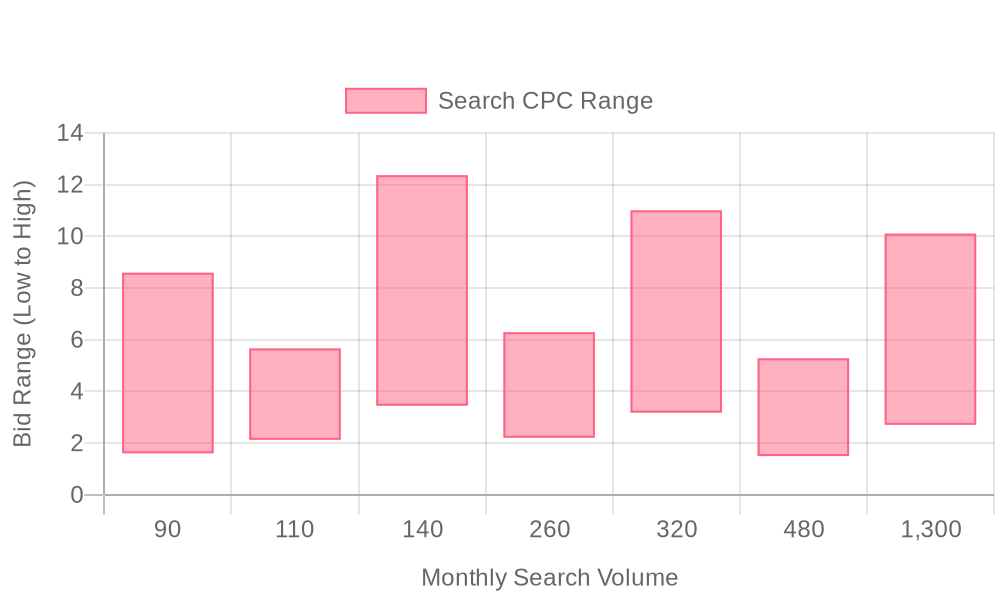
Supercharge your lead generation with a FREE Google Ads audit - no strings attached! See how you can generate more and higher quality leads
Get My Free Google Ads AuditFree consultation

No commitment
Supercharge your lead generation with a FREE LinkedIn Ads audit - no strings attached! See how you can generate more and higher quality leads
Get My Free Google Ads AuditFree consultation

No commitment
Supercharge your lead generation with a FREE Meta Ads audit - no strings attached! See how you can generate more and higher quality leads
Get My Free Google Ads AuditGet My Free LinkedIn Ads AuditGet My Free Meta Ads AuditFree consultation

No commitment
Supercharge your lead generation with a FREE Google Ads audit - no strings attached! See how you can generate more and higher quality leads
Get My Free Google Ads AuditFree consultation

No commitment
In today's competitive advertising landscape, creating effective Google Ads for Petroleum Businesses is essential for connecting with decision-makers in the oil and gas sector. These businesses face unique challenges when it comes to targeting precise keywords, managing fluctuating budgets due to oil price variations, and adhering to international trade regulations. These factors, combined with the growing interest in renewable energy and digital transformation, make a nuanced approach crucial. Google Ads offers a powerful platform to align digital marketing efforts with traditional sales processes, directly targeting prospects in their moments of need. By leveraging tools that provide visibility into anonymous visitor behavior, petroleum businesses can ensure their ad spend is directed towards high-value prospects and capture valuable intents from digital interactions, enhancing online visibility, and measuring success throughout the sales journey.

Petroleum businesses can unlock substantial growth and measurable ROI by targeting decision-makers during high-intent search moments. With a well-structured Google Ads approach, these companies achieve precise market segmentation and amplify brand credibility within a highly regulated landscape. Each tactical decision, from keyword selection to campaign optimization, directly impacts lead quality and sales velocity.
Revenue teams in the petroleum sector need digital strategies that move beyond broad impressions and anonymous clicks. By leveraging advanced tools to identify visiting organizations, marketers ensure their ad budgets reach the most promising accounts, while unifying performance data to inform smarter investment.

Petroleum businesses operate within a highly competitive, rapidly shifting landscape where precision and agility in marketing are essential for growth. Digital advertising platforms such as Google Ads enable petroleum marketers to engage decision-makers at pivotal moments, capturing critical demand that traditional channels often miss.
The convergence of digital marketing, real-time data, and precise targeting empowers petroleum businesses to accelerate growth, capture new revenue streams, and maintain a competitive edge in a demanding sector. To experience these capabilities firsthand, get started for free with Sona.

Petroleum businesses can accelerate growth by expanding digital marketing efforts beyond well-worn tactics, focusing on emerging channels and overlooked audience segments. By leveraging the latest advances in analytics and audience identification, teams can effectively target new buyers and capture market share in competitive environments.
Embracing a data-driven approach to growth uncovers new business opportunities and ensures digital marketing for petroleum businesses evolves with industry trends. By unifying visitor insights, intent signals, and campaign data, B2B teams can execute strategies that drive measurable improvements in revenue and brand authority. Ready to accelerate your growth? Get started for free with Sona.
Petroleum businesses operate in a uniquely fragmented market, with stakeholders ranging from industrial procurement teams to urban residential customers. Precision in audience segmentation empowers these companies to deliver highly relevant messages that resonate with each group, increasing engagement and ultimately driving more qualified leads into the sales pipeline.

| Industry | Keyword | Monthly Search Volume | Competition Level | Low Bid | High Bid |
| Petroleum Businesses | atlantic gas company | 90 | LOW | 1.61 | 8.59 |
| Petroleum Businesses | oil trading companies | 110 | LOW | 2.13 | 5.66 |
| Petroleum Businesses | oil companies in my area | 140 | MEDIUM | 3.45 | 12.36 |
| Petroleum Businesses | fuel oil companies in my area | 260 | LOW | 2.21 | 6.29 |
| Petroleum Businesses | oil & gas companies | 320 | LOW | 3.18 | 11 |
| Petroleum Businesses | valley oil company | 480 | LOW | 1.5 | 5.28 |
| Petroleum Businesses | fuel oil companies near me | 1300 | MEDIUM | 2.71 | 10.1 |
Effective keyword strategies drive measurable revenue outcomes for petroleum businesses by connecting urgent, high-intent buyers with tailored solutions. Leveraging behavioral data from site visitors and historical campaign performance allows marketers to prioritize terms that directly correlate with bottom-line impact.
With unified keyword and intent data, B2B marketers can seamlessly sync enriched audiences and lead signals across Google Ads and CRM systems. This closed-loop strategy ensures that every relevant search is mapped to the appropriate audience segment, enabling continuous optimization and high-ROI demand generation for petroleum businesses. To see how you can streamline this process, get started for free with Sona.

Success in Google Ads for petroleum businesses begins with robust keyword research and precise organization. The most effective approach segments keywords by core service areas—such as bulk fuel supply, oilfield equipment, or industrial lubricants—while integrating geographic modifiers to capture market demand at the local, regional, or national level. This structure ensures campaigns reach high-intent buyers searching for specific solutions, like “diesel delivery in Houston” or “API-certified valves Chicago,” rather than wasting spend on generic or unrelated queries. For industry-specific keyword inspiration, explore this oil and gas keywords list to strengthen your targeting strategy.
Modern marketers can further refine these keyword lists by leveraging real-time intent signals and analyzing trending industry demands. By identifying which companies and decision-makers are actively searching for petroleum products or services, teams can shift budget toward high-probability accounts, ensuring that ad spend is focused on reaching those most likely to convert. This enhanced visibility into in-market behavior not only drives better cost efficiency but also improves the relevance of every impression delivered.
Compelling ad copy for petroleum campaigns must speak directly to the critical pain points and urgent needs of the industry’s buyers. Messaging should focus on safety compliance, rapid delivery, and product reliability, while providing clear solutions to challenges such as regulatory requirements or supply chain disruptions. Incorporating trust builders—like ISO certifications, regulatory compliance badges, or client testimonials—reinforces credibility and drives higher engagement rates among cautious B2B audiences. For creative guidance, review Google Ads best practices on balancing recommended strategies with practical campaign management.
With access to account-level data and advanced audience segmentation, marketers are now able to personalize ad content to the decision-makers most likely to take action. For example, messaging can dynamically adjust based on whether the visitor is a procurement manager at a refinery or an operations director at a logistics firm, ensuring each ad resonates with the recipient’s specific priorities. This data-driven approach increases relevance and amplifies conversion opportunities at every stage of the buying journey.
Landing pages for oil and gas marketing must achieve seamless alignment with the promise and tone of the ad copy while guiding users effortlessly toward conversion. Every element—headline, imagery, form fields, and calls-to-action—should reinforce the service value and address common buyer concerns like turnaround time, compliance documentation, or technical support. Optimizing for mobile responsiveness and minimizing navigation friction are essential, as industrial buyers often conduct research from multiple devices and locations. For inspiration on industry-specific landing page strategy, see this Jiffy Lube marketing campaign.
Ongoing refinement of landing pages is best achieved through continuous data analysis. By tracking user behavior, identifying bottlenecks, and understanding which content drives the most conversions, marketers can systematically eliminate obstacles to lead submission. Integrating visitor identification technology allows teams to tailor page content to the organization or individual, increasing the likelihood of a completed inquiry or request for proposal.
Continuous performance improvement is a cornerstone of digital marketing for petroleum businesses. Advanced analytics platforms empower marketers to monitor campaign health in real time, rapidly identifying which keywords, ads, and audiences are delivering the highest ROI. Automated budget adjustments, bid strategies, and creative rotations keep campaigns agile in response to changing market dynamics or shifts in buyer demand. Access the official Google Ads homepage for additional resources on optimizing your campaigns.
Integrating CRM and ad platform data unlocks end-to-end visibility, from first website interaction to closed contract. When audience and lead data sync seamlessly between marketing and sales tools, teams gain a clear understanding of which campaigns generate not just clicks, but actual revenue. This closed-loop optimization allows for more accurate attribution, better forecasting, and smarter investment in high-performing Google Ads strategies tailored to the petroleum industry. To experience these benefits firsthand, get started for free with Sona.

Petroleum businesses seeking stronger market positioning benefit from a multi-faceted digital strategy that blends educational engagement, localized operations, and influential partnerships. The most successful growth initiatives combine targeted advertising efforts with actionable data, allowing teams to allocate resources to the highest impact opportunities. For tailored guidance on digital marketing in this sector, explore this resource on digital marketing strategies for oil and gas companies. For more B2B growth ideas, you can also consult our actionable marketing playbooks.
Effectively running Google Ads in the petroleum industry requires a well-structured approach that emphasizes smart keyword targeting, audience segmentation, and consistent optimization. By integrating advanced tools and data analysis platforms, businesses can create a seamless and efficient advertising ecosystem. As the industry evolves, staying attuned to emerging digital marketing trends and regulatory changes ensures continued success and growth. Solutions that emerge from a detailed understanding of visitor engagement are instrumental in navigating these complexities, ensuring efforts are focused on generating high-value results while allowing sales and marketing teams to work in concert with real-time insights. Ready to optimize your petroleum marketing efforts? Get started for free with Sona.
In conclusion, leveraging Google Ads for your petroleum business can significantly enhance your online presence and drive meaningful engagement with potential customers. The strategies and best practices we've explored are specifically designed to address the unique challenges faced by the petroleum industry, from targeting the right audience to optimizing ad spend for maximum ROI.
Throughout this article, we've discussed how effective keyword targeting, crafting compelling ad copy, and utilizing advanced analytics can transform your advertising approach. By implementing these strategies, you can overcome the barriers to visibility and lead generation, ensuring your business stands out in a competitive market.
The potential for growth and increased customer reach is within your grasp. By adopting a strategic approach to your Google Ads campaigns, you're not only investing in visibility but also in the sustained success of your petroleum business. Embrace these insights and take actionable steps today to see tangible results.
We invite you to start for free to experience our platform's unique capabilities and discover how it can further enhance your advertising strategy. Unlock the full potential of your campaigns with our innovative tools designed to drive actionable insights and unified data solutions.
Best practices include targeting high-intent keywords specific to petroleum, leveraging advanced tools to identify visiting organizations, using ad extensions to boost credibility, and aligning digital ads with offline marketing efforts.
Petroleum businesses can optimize campaigns by continuously monitoring bids, placements, and conversion rates, using automation tools for real-time budget adjustments, and integrating CRM data to ensure seamless lead follow-up.
Petroleum companies should target keywords related to urgent needs and specific services such as 'emergency fuel delivery,' 'bulk diesel supply,' and integrate local modifiers for geo-targeted searches.
Common pitfalls include not targeting precise keywords, failing to align ads with offline efforts, and neglecting the use of negative keywords to filter out irrelevant traffic.
Success can be measured by tracking online and offline conversions, aligning Google Ads data with CRM systems, and using advanced attribution features to gain a holistic view of ROI.
Join results-focused teams combining Sona Platform automation with advanced Google Ads strategies to scale lead generation

Connect your existing CRM

Free Account Enrichment

No setup fees
No commitment required

Free consultation

Get a custom Google Ads roadmap for your business
Join results-focused teams combining Sona Platform automation with advanced Meta Ads strategies to scale lead generation

Connect your existing CRM

Free Account Enrichment

No setup fees
No commitment required

Free consultation

Get a custom Google Ads roadmap for your business
Join results-focused teams combining Sona Platform automation with advanced LinkedIn Ads strategies to scale lead generation

Connect your existing CRM

Free Account Enrichment

No setup fees
No commitment required

Free consultation

Get a custom Google Ads roadmap for your business
Join results-focused teams using Sona Platform automation to activate unified sales and marketing data, maximize ROI on marketing investments, and drive measurable growth

Connect your existing CRM

Free Account Enrichment

No setup fees
No commitment required

Free consultation

Get a custom Google Ads roadmap for your business
Over 500+ auto detailing businesses trust our platform to grow their revenue
Join results-focused teams using Sona Platform automation to activate unified sales and marketing data, maximize ROI on marketing investments, and drive measurable growth

Connect your existing CRM

Free Account Enrichment

No setup fees
No commitment required

Free consultation

Get a custom Google Ads roadmap for your business
Over 500+ auto detailing businesses trust our platform to grow their revenue
Join results-focused teams using Sona Platform automation to activate unified sales and marketing data, maximize ROI on marketing investments, and drive measurable growth

Connect your existing CRM

Free Account Enrichment

No setup fees
No commitment required

Free consultation

Get a custom Google Ads roadmap for your business
Over 500+ auto detailing businesses trust our platform to grow their revenue
Our team of experts can implement your Google Ads campaigns, then show you how Sona helps you manage exceptional campaign performance and sales.
Schedule your FREE 15-minute strategy sessionOur team of experts can implement your Meta Ads campaigns, then show you how Sona helps you manage exceptional campaign performance and sales.
Schedule your FREE 15-minute strategy sessionOur team of experts can implement your LinkedIn Ads campaigns, then show you how Sona helps you manage exceptional campaign performance and sales.
Schedule your FREE 15-minute strategy sessionOur team of experts can help improve your demand generation strategy, and can show you how advanced attribution and data activation can help you realize more opportunities and improve sales performance.
Schedule your FREE 30-minute strategy sessionOur team of experts can help improve your demand generation strategy, and can show you how advanced attribution and data activation can help you realize more opportunities and improve sales performance.
Schedule your FREE 30-minute strategy sessionOur team of experts can help improve your demand generation strategy, and can show you how advanced attribution and data activation can help you realize more opportunities and improve sales performance.
Schedule your FREE 30-minute strategy sessionOur team of experts can help improve your demand generation strategy, and can show you how advanced attribution and data activation can help you realize more opportunities and improve sales performance.
Schedule your FREE 30-minute strategy session





Launch campaigns that generate qualified leads in 30 days or less.
